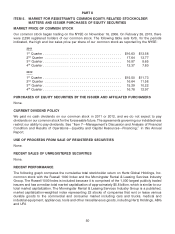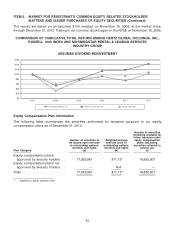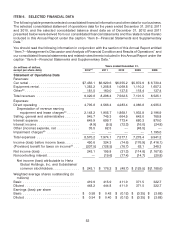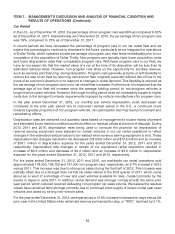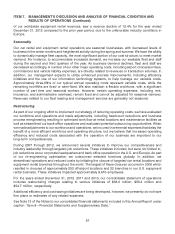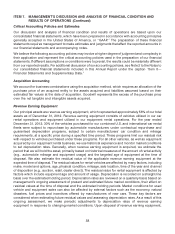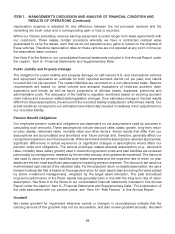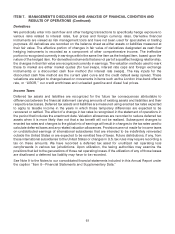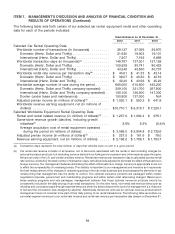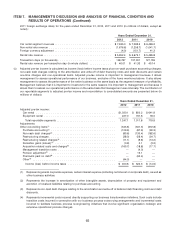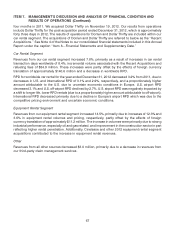Hertz 2012 Annual Report Download - page 82
Download and view the complete annual report
Please find page 82 of the 2012 Hertz annual report below. You can navigate through the pages in the report by either clicking on the pages listed below, or by using the keyword search tool below to find specific information within the annual report.ITEM 7. MANAGEMENT’S DISCUSSION AND ANALYSIS OF FINANCIAL CONDITION AND
RESULTS OF OPERATIONS (Continued)
Critical Accounting Policies and Estimates
Our discussion and analysis of financial condition and results of operations are based upon our
consolidated financial statements, which have been prepared in accordance with accounting principles
generally accepted in the United States of America, or ‘‘GAAP.’’ The preparation of these financial
statements requires management to make estimates and judgments that affect the reported amounts in
our financial statements and accompanying notes.
We believe the following accounting policies may involve a higher degree of judgment and complexity in
their application and represent the critical accounting policies used in the preparation of our financial
statements. If different assumptions or conditions were to prevail, the results could be materially different
from our reported results. For additional discussion of our accounting policies, see Note 2 to the Notes to
our consolidated financial statements included in this Annual Report under the caption ‘‘Item 8—
Financial Statements and Supplementary Data.’’
Acquisition Accounting
We account for business combinations using the acquisition method, which requires an allocation of the
purchase price of an acquired entity to the assets acquired and liabilities assumed based on their
estimated fair values at the date of acquisition. Goodwill represents the excess of the purchase price
over the net tangible and intangible assets acquired.
Revenue Earning Equipment
Our principal assets are revenue earning equipment, which represented approximately 56% of our total
assets as of December 31, 2012. Revenue earning equipment consists of vehicles utilized in our car
rental operations and equipment utilized in our equipment rental operations. For the year ended
December 31, 2012, 30% of the vehicles purchased for our combined U.S. and international car rental
fleets were subject to repurchase by automobile manufacturers under contractual repurchase and
guaranteed depreciation programs, subject to certain manufacturers’ car condition and mileage
requirements, at a specific price during a specified time period. These programs limit our residual risk
with respect to vehicles purchased under these programs. For all other vehicles, as well as equipment
acquired by our equipment rental business, we use historical experience and monitor market conditions
to set depreciation rates. Generally, when revenue earning equipment is acquired, we estimate the
period that we will hold the asset, primarily based on historical measures of the amount of rental activity
(e.g., automobile mileage and equipment usage) and the targeted age of equipment at the time of
disposal. We also estimate the residual value of the applicable revenue earning equipment at the
expected time of disposal. The residual values for rental vehicles are affected by many factors, including
make, model and options, age, physical condition, mileage, sale location, time of the year and channel
of disposition (e.g., auction, retail, dealer direct). The residual value for rental equipment is affected by
factors which include equipment age and amount of usage. Depreciation is recorded on a straight-line
basis over the estimated holding period. Depreciation rates are reviewed on a quarterly basis based on
management’s ongoing assessment of present and estimated future market conditions, their effect on
residual values at the time of disposal and the estimated holding periods. Market conditions for used
vehicle and equipment sales can also be affected by external factors such as the economy, natural
disasters, fuel prices and incentives offered by manufacturers of new cars. These key factors are
considered when estimating future residual values and assessing depreciation rates. As a result of this
ongoing assessment, we make periodic adjustments to depreciation rates of revenue earning
equipment in response to changing market conditions. Upon disposal of revenue earning equipment,
58




